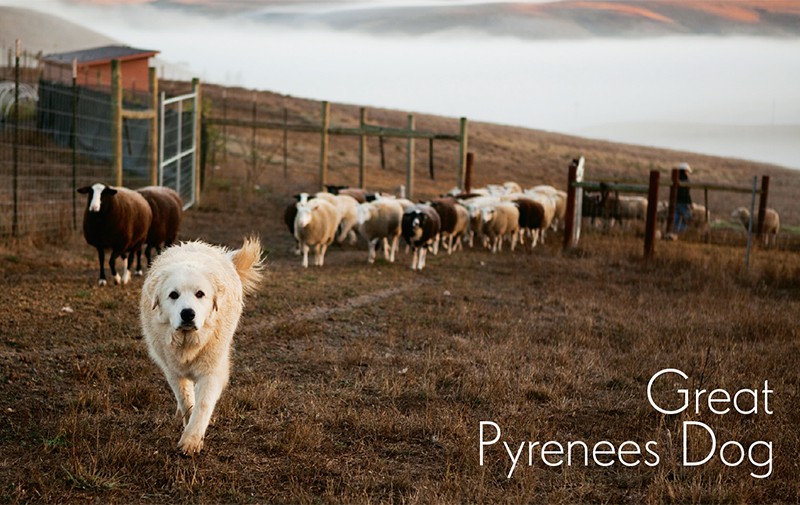
Origin
The Great Pyrenees dog, or the Pyrenean Mountain Dog as it is known in Europe, belongs to a group of livestock-guarding dogs whose origins can be traced back 10,000 or 11,000 years to some of the earliest known domesticated canines. From their origins in Asia Minor, the predecessors of the Great Pyrenees followed their masters west into the Pyrenees mountain range of southwestern Europe around 3,000 BC. Once there, it wasn’t long before the animals’ size, strength, and stock-guarding prowess endeared them to the Basque shepherds who spent their days tending flocks in the high, rugged mountains.
Thanks to the region’s relative isolation, the Great Pyrenees developed in parallel with other modern dog breeds, rather than descending from them. As a result, the breed remained virtually unchanged for hundreds of years.
History
By the 15th century these “great dogs of the mountains” had found their way out of the high alpine pastures and into polite French society as guardians of the Chateau de Lourdes. In 1675 the breed was adopted as the royal dog of France by the dauphin of the court of King Louis XIV, and from then on these stately white dogs were a favorite accoutrement of French royalty.
The Great Pyrenees officially arrived in North America in 1824, when General Lafayette imported two males as a gift to his friend, John Stewart Skinner, author of The Dog and the Sportsman, the first sporting book about dogs published in America. However, it would be another hundred years before the breed really took hold in the New World. Thanks to the efforts of Mr. and Mrs. Francis V. Crane of Needham, Massachusetts, quality breeding stock was finally imported in the early 1930s, and in February 1933 the Great Pyrenees was officially recognized by the American Kennel Club.
Appearance & Temperament
The coat of the Great Pyrenees is not only its most striking physical attribute, but also an important contributing factor to its success as a livestock-guarding dog. The Pyrenees’ double coat consists of a soft, downy undercoat combined with a thicker, nearly weatherproof outer coat. Together these layers help shield the dog from harsh weather conditions while offering protection from the teeth and claws of would-be predators. The coat also serves as camouflage, allowing the guardian to blend in with his flock.
Great Pyrenees are usually content to lie low until called into action. They are nocturnal animals and prefer to spend daylight hours resting so they can be alert and on guard throughout the night. Beth Viney, longtime Great Pyrenees owner and a member of the board of directors of the Great Pyrenees Rescue of Wisconsin, says, “Each night my two Pyrs will go out and climb the hill on our [15-acre] property. One faces east, one faces west, and they guard from those points. Together they visually cover 360 degrees. This is a behavior called “broadcasting.” Tundra, our younger female, will stay out all night, and Czar, our older male, will still stay out until three or four in the morning—even at nine years of age. They are very focused, driven workers.”
Viney also notes that, while Great Pyrenees are extremely serious at work, they are also very gentle, docile, and loving pets. This naturally calm, laid-back demeanor not only makes them ideal candidates for other modern-day canine careers, such as therapy dogs, it also helps them move freely through a flock of flighty sheep, goats, or other livestock without causing them to scatter.
At Work
Great Pyrenees fall under the category of working dogs known as livestock-guarding dogs, or LGDs. They are not herding dogs but rather full-time members of the flock they are assigned to protect. An LGD’s one and only job is to protect its flock—be that a group of sheep, goats, or cattle or simply its human family. “Great Pyrenees are an amazing example of the genetics of behavior,” notes cheesemaker Marcia Barinaga of Barinaga Ranch in Marshall, California. “They’ve been protecting sheep for centuries, and there is nothing else they’d rather do.” Despite the constant threat of coyotes and mountain lions, Barinaga has had zero predator loss in the four years she’s raised sheep alongside their Great Pyrenean guardians.
Unlike many other working breeds whose skills must be honed through constant training, Great Pyrenees act primarily on instinct. Beyond socializing the dog with its flock from an early age, very little training is required to transform a young puppy into a serious and formidable guard dog. “When we brought our first dog, Big Otis, home for the first time, he made one circuit of the pasture, climbed up a hill, and started guarding,” says Barinaga. “With the good dogs, they just go to work. I love my dogs because they’re so noble, so beautiful, and most of all,” she says, “they’re professionals.”





One thought on “Great Pyrenees Dogs”